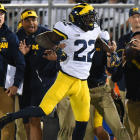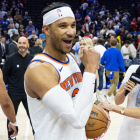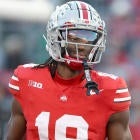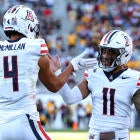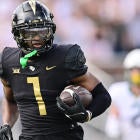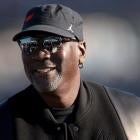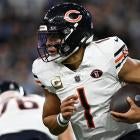Prospects had clearly defined positions at the NFL level at one point in the not-too-distant past. But it's moving closer to becoming a positionless league, and this class of defensive backs in the 2019 NFL Draft will add more evidence to that idea.
Most of the best safeties have experience in the slot and playing both free and strong, while so many of the top corners can play inside and out. It's time to hand out pro comparisons for these defensive backs.
As for the actual draft, you'll be able to stream our live coverage right here on CBS Sports HQ (or download the CBS Sports app for free on any mobile or connected TV device) breaking down all the picks and everything you need to know during draft weekend.
It's important to remember NFL comparisons for draftees don't intend to guarantee a prospect will have the exact same career as his professional counterpart. In this series, I'll went through the top prospects at every position and give NFL comparisons -- some current players, some former. These comparisons are not based on size. They're almost solely stylistic.
This is the final installment in the comparison series for this draft class.
Previous installments: Quarterbacks, Running Backs, Wide Receivers, Offensive Linemen, Tight Ends, Edge Rushers, Defensive Linemen, Linebackers
(Prospects are listed in the order they appear in my draft rankings.)
Cornerbacks
Greedy Williams, LSU
NFL comparison: Stephon Gilmore
Gilmore was a sticky-as-glue man-to-man corner at South Carolina, and that led to him being a top 15 pick in the 2012 Draft. His length, smooth athleticism, and good ball skills allowed him to thrive in the highly competitive SEC. Much of the same is true about Williams, another somewhat tall, effortless athlete with above-average downfield speed and awareness to play the ball when it's arriving. Williams is the preeminent man coverage corner in this class.
Deandre Baker, Georgia
NFL comparison: Tre'Davious White
Like White, Baker isn't a size/speed/athleticism specimen. And he isn't a big outside cornerback at 5-foot-11 and 193 pounds. Also like White, Baker simply does everything you ask of him as a corner. Play press man and battle with a bigger receiver? Sure thing. Sit in zone and spring forward to make plays on the football on comebacks and in-breaking routes? No problem. Both White and Baker were super productive with pass breakups and interceptions in the SEC and are as savvy as it comes with their mirroring abilities.
Byron Murphy, Washington
NFL comparison: Casey Hayward
While "zone corner" has a negative connotation to some, it shouldn't. It takes plenty of intelligence and a lot of twitchiness to excel in zone, and Hayward has become an elite player at his position without staying in the pockets of receivers all over the field. Murphy can be that type of high-impact, zone cornerback at the NFL level, and he has the smoothness in his hips and ankles to calmly man the slot if needed.
Julian Love, Notre Dame
NFL comparison: Avonte Maddox
Maddox flew amazingly under the radar as a prospect after posting eight interceptions and 32 pass breakups in his final three years at Pittsburgh. An instinctive, quick-twitch corner lacking in the size department but making up for it with every other requisite element of playing the position, he has emerged as the best corner in Philadelphia's secondary. Love's a similar prospect. Not the fastest nor the biggest. He has an argument for the best combination of awareness, explosion, and ball skills of any corner in the class.
Amani Oruwariye, Penn State
NFL comparison: Pierre Desir
Coming from the Division II ranks, it took Desir a few seasons in the NFL to fully acclimate. In 2018, his length, physicality, coverage versatility, and ball skills allowed him to emerge as the Colts' most impactful cornerback, and he was awarded with a new contract this offseason. Oruwariye reminds me of Desir because of his athletic gifts at over 6-1 and 200 pounds. His smoothness in man and savvy in zone make him a fun, valuable prospect at the outside cornerback position.
Justin Layne, Michigan State
NFL comparison: Marlon Humphrey
Layne and Humphrey are in-your-face size/speed/athleticism freaks on the outside who win with an ultra-physical nature at the line of scrimmage and when playing the ball at any level of the field. Neither are true burners. It doesn't matter. Their route-recognition skills, length, and recovery speed will keep them around the football frequently.
David Long, Michigan
NFL comparison: Darrelle Revis
I know, I know, I know. Revis should be sacred when it comes to these comparisons. I don't think Long will be the next Revis. I think their styles of play (and athleticism) are closely comparable. Revis smothered everyone in bump-and-run coverage and had the otherworldly movement skills to almost instantly react to every wideout's movement. Long was the premier press man cornerback I watched in this draft class ... then he had a combine nearly identical to Revis' pro day in 2007.
Safety
Juan Thornhill, Virginia
NFL comparison: Kevin Byard
Byard was a game-changing ball hawk at Middle Tennessee State and loaded the stat sheet in the tackle department. Thornhill did both those things at Virginia too. Thornhill and Byard have a tendency to dive into tackles which can lead to unreliability bringing ball-carriers to the turf, but even with the occasional miss, their high tackle numbers in college indicate they were essentially always around the football. In the end though, Thornhill, like Byard, will make the greatest impact in the NFL because of his insane range from the deep middle, and Thornhill tested as a better athlete than the Titans' star.
Amani Hooker, Iowa
NFL comparison: Desmond King
King and Hooker -- like many Iowa secondary members -- are extraordinarily versatile. Strong safety. Free safety. Slot corner. Off-ball linebacker. They can do it all. King and Hooker tested noticeably well at their respective combines. King has quickly become one of the best slot corners in football with the Chargers. Hooker will probably stay at safety in the pros, and that's fine. He excels in robber coverage, can get to the sideline from center field, and is a steady run defender. He is a step ahead of everyone else on the field thanks to excellent football intelligence.
Nasir Adderley, Delaware
NFL comparison: Xavier Woods
Adderley has long been a favorite of Draft Twitter because of the springy range he showcased at Delaware. Woods was a rangy, playmaker during his tenure at Louisiana Tech, provided some slot corner versatility but wasn't the surest tackler. That's precisely the type of prospect I saw on film while watching Adderley.
Chauncey Gardner-Johnson, Florida
NFL comparison: Jordan Poyer
Is Gardner-Johnson a corner or safety? He played both positions so often at Florida it's hard to tell. Poyer was a productive outside corner at Oregon State before moving to safety in the NFL. CGJ is comfortable sliding down into the slot, flashes big-time range in deep coverage, gets the job done as a blitzer, and you don't have to worry about his tackling. Poyer has been a multi-faceted asset for the Bills, often switching responsibilities with teammate Micah Hyde.
Johnathan Abram, Mississippi State
NFL comparison: Reshad Jones
Jones and Abram are at their best relatively near the line of scrimmage, where they can halt the run and use their impressive speed to deliver devastating hits on receivers in the short to intermediate areas. Similar to Jones, Abram is best if allowed to play in attack mode at all times. His deep coverage leaves a little to be desired.
Deionte Thompson, Alabama
NFL comparison: Tashaun Gipson
Thompson didn't have standout statistics at Alabama yet routinely exhibited the speed, explosiveness, and tracking to make high-end plays down the field from the middle. In his prime, Gipson proved to be a somewhat lanky but very useful turnover-machine on the back end. Thompson isn't a flashy player but won't be liability at the next level.
Taylor Rapp, Washington
NFL comparison: Budda Baker
Rapp and Baker are smaller, pesky safeties with tremendous twitchiness, play-recognition skills, and tackling prowess. They can be utilized in a variety of ways and provide production across the entire stat sheet, like Baker did in his second season with the Cardinals, a year that included 102 tackles, two sacks, and two forced fumbles. Let Rapp roam free at the second and third levels of the defense, and he'll contribute in a variety of ways.












